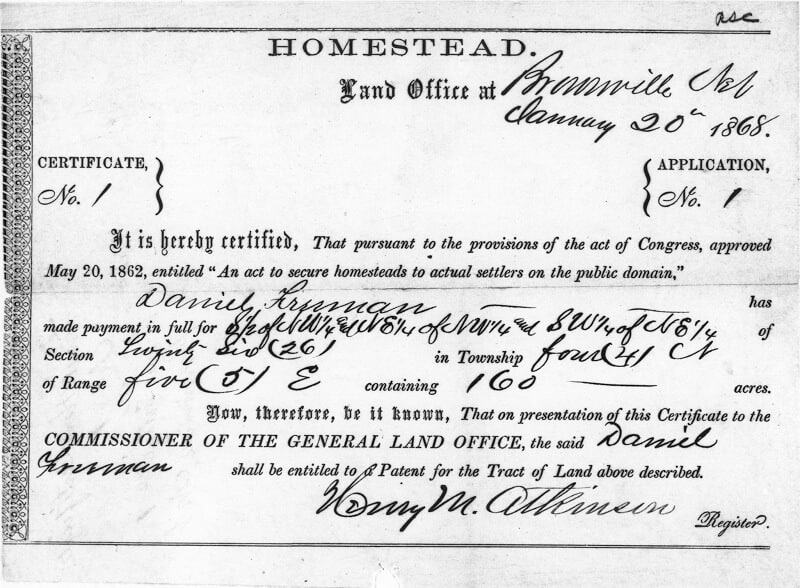My great grandparents purchased their homestead via the Homestead Act of 1862. My family and I were curious as to what the Homestead Act actually entailed so we did some research.
Per the law that was signed into effect by then President Lincoln in May of 1862, the Homestead Act was designed to encourage people to migrate west in exchange for 160 acres of public land.

Some of my family came over as indentured servants from Ireland in the late 1600s. Still others would marry into the Cherokee Nation and thus be denied property due to their Native American heritage.
Unfortunately, during the 1600s to the mid 1900s there was a huge stigma regarding ones nationality. It wasn’t at all unusual for people to try and pass themselves off as white when in fact they were African American and lighter skin tones or Native American and lighter skin tones.
There was much that was kept quiet back then in regards to ones heritage and it was considered preferential to pass oneself off as a white person in an effort to keep the gossip and the rules to a minimum.
My grandparents migrated west in an effort to shed the stigma of their true heritage. They kept it very quiet as to their true beginnings and started fresh when they arrived in the West to claim their Homestead.
It would take hard work and a lot of blood, sweat, and tears to overcome their past but they were determined to stand tall and keep the past where it belonged, in the past.
In the end, they owned a very large parcel of property and worked hard at farming and at a sawmill that they also owned. It paid the bills, kept the food on the table, and taught all of their kids, grand kids and great grand kids a huge lesson on overcoming any obstacle that may come their way. I’ve visited the old homestead property a few times in my lifetime and treasure every moment.
I ponder what life must have been like for them as they struggled to make ends meet and feed their 11 children. I know that they both worked hard and that the kids, as soon as they were old enough, were busy helping as well. Life back then was harder but it also offered up a strong work ethic that today’s society seems to be seriously lacking.
Table of Contents:
The Homestead Act Of 1862
There were some very strict stipulations in regards to this 160 acres. The homesteaders must first complete five-years of continuous living on the property prior to receiving their ownership. They were also required to pay a small filing fee.
The homesteaders must also be either the head of household or at least 21 years of age in order to file and gain the homestead property. Both men and women could purchase land so many would have the women go in and purchase a parcel and then later the men would purchase an adjacent parcel in an effort to capitalize on the benefits of owning property.
It wasn’t at all unusual for larger sized families to try and gain more property by such tactics. Free slaves were also allowed to purchase property as long as they could meet the requirements of residency and do the work that was required.
The property, after six-months of residency, could then be purchased by paying the US Government $1.25 per acre of property. By the 1900s, over 80 million acres of land had been purchased and distributed to American citizens.
While $1.25 may seem fairly cheap for the time period, it’s important to understand that $1.25 would be equivalent to $2,486.21 in today’s dollars. In short, that’s still a lot of money and when you consider wages vs. prices you can see that homesteaders had to work hard for their ownership of such a piece of property. For many, it was their life savings to own a parcel of land.
The United States had set up different laws wherein applicants would be able to acquire their own piece of property. All in all, over 160 million acres would be sold under these terms. As much as 10 percent of the area of the United States would be given free to as many as 1.6 million homesteaders.

The majority of the properties were west of the Mississippi. As an extension of this law, Northerners that wished to be farmers would be allowed to own and operate their farms.
This was directly opposite of the South which allowed slave-owners to buy up large parcels of land and use their slaves for labor thus shutting out the free white farm owners.
The way the laws were written allowed adults who hadn’t taken up any arms against the government of the United States to apply for land ownership. At the time, women, and immigrants that had made applications for citizenship were also eligible.
In 1866, blacks, or African Americans, were also included. Laws were set forth to ensure that every free person could have land if they simply followed the due process of law.
Sadly, in the southern states, there were many cases of inequality. If one wished to have land under the Timber Culture Act (in 1873) that person would be required to plant trees on the property.
There wasn’t a residency requirement for such properties, however, the owners must be able to plant the required number of trees if they hoped to retain the particular parcel of land. This could also be quite expensive unless they had an unlimited supply of seedlings free of charge.
There were several different Homestead Acts that would encompass specific details that must be met in order for a property to be procured. The rules and regulations would be dependent on the actual location of the property and the year in which the property was purchased. Various acts would have specifics that must be met in accordance with the regulations in order to keep to the letter of the law.
The main requirements of the law were that any homesteader must improve the property. This could be by building dwellings or cultivating the land or both. After they completed the five year residency as required, they could own the land free and clear.
Should the homesteader wish to own the property earlier, they must pay the government $1.25 per acre but only after they had completed six months on the property.
Upon the completion of the Civil War, Union soldiers were able to deduct the time that they had served from their residency requirements. This greatly helped in streamlining the required residency times for these soldiers and their families. Many were able to own their own property in just a few weeks or months vs the usual six month wait or five year wait.
Early Beginnings Of The Homestead Act
As early as the late 1700s this Homestead Act was in the makings with the United States Government. Over the course of time this act would evolve and there would be several different Homestead Acts that people could take advantage of in order to gain their own piece of property.
Different years would have different requirements so it was vital to know the letter of the law when choosing or determining which parcel to purchase.
Every effort was made by the government at that time to ensure that everything was done in accordance to the letter of the law, however, it’s important to note that since everything was done by hand there was plenty of room for error.
Filing Requirements
In order to file their property, homesteaders must first file an intent with the Land Office that was located nearest to their chosen parcel of land.
There would be a brief search for any previous ownership in regards to the particular parcel that a homesteader wished to purchase. After this brief search, the property would then be described according to the survey coordinates.
The homesteader must then pay a $10 fee to the land and a fee of $2 to the agent at that land office for their research.
Upon application completion and with receipt in hand, the person would then return to the property and begin their improvement process. They must build a home, work the land, and show that they were continually improving the property as per the guidelines set forth by the United States government.
Upon completion of their five year “probationary” period, the homesteader would then round up a few neighbors or friends who would vouch for their improvements as the gospel truth. These people must make statements and sign the “proof” paperwork before the homesteader could own the property outright.
At this point in time, the homesteader would then return to the Land Office and pay their final $6 fee for the “title” of the land. This would come with a document that was signed by the then current President of the United States of America. This document would usually be displayed upon the wall of the homestead to show that the person owned the property.
The entire process must be completed within 7 years for everything to be completely valid and admissible should there be any concerns regarding who actually owned the property in question.
Repealing The Homestead Act
In 1976 the Homestead Act was repealed. However, there were some provisions for the Homestead Act that remained in effect in the state of Alaska until 1986.
Over the years, the Taylor Grazing Act (founded in 1934) would considerably decrease the amount of land that was available to homesteaders. During this time, the claims for Homesteads would sharply decline.
For landowners, the Homestead Act of 1862 was considered to be one of the most important steps in United States history for land distribution. There would be many repercussions in regards to this legislation and even today, the term “Free Land” has long since faded in memory.
National Parks
In 1936 a law was passed in Congress regarding Public Lands. Then President Franklin D. Roosevelt would sign the law of the Homestead National Monument of America in an effort to retain property for posterity that would be considered to be National monuments.
This was to allow for appropriate memorials of the hardships and the life that the pioneers led in an effort to retain their own personal property. It also allowed for the gateway of the National Parks systems that we all enjoy today.
How The Homestead Act Was Abused
While the intention of the Homestead act was for everyone to be able to own a piece of property, there were many ways that people would manipulate the system.
They would manipulate it to gain access to water and other resources or act as fronts for larger cattle operations. This would preclude other ranchers form having access to that particular body of water.
Many would file for a particular piece of property that was surrounding a good water source, however, instead of building a home there, they would run the cattle so that they had plenty of drinking water for the cattle.
Over the course of time as the government caught on they would begin to charge different fees for such trickery.
Another common scheme was to gain access to natural minerals and resources such as silver and cold. They would go this route in an effort to find the minerals prior to laying claim to them under the various mining acts. This could reduce the amounts of the royalties that they would be required to pay.
In an effort to curb such abuse, the government would require affidavits from witnesses that stated that the claimant was residing on the particular parcel of property. Of course, some of the witnesses were bribed, coerced, or in cahoots with the particular land claimant.
Another common ruse was for larger sized families to have the older children “purchase” the adjacent pieces of property. After several of these were purchased the family would “go in” together to have quite the sizable estate.
While this wasn’t quite as bad as some of the above-mentioned forms of abuse, it did cause a few issues in regards to the legality of the procuring of the various land plots.
Today, the Homestead Act of 1862 is but a distant memory for most. Many of the properties have been sold and subdivided and no longer remain in the family. Families have scattered to the four winds and are no longer working together for the American Dream.
While land can still be purchased and farms or ranches still are being bought and sold, they are now being bought and sold as private real estate deals and not via a Homestead Act. For many, this means years of saving money and a lot of hard work.
Thankfully today, there are many ways that anyone can purchase property. With a bit of creativity and thought just about anyone can buy property.


Hi, I’m Linda. I’m a mom, grandmother, homesteader. I love simple living and enjoy my life on a homestead where I garden, raise a variety of animals and strive for a life more like my grandparents lived.
My goal is to enrich life by living it as simply as possible and focusing on the way my grandparents did things. Life is so much more fun when it’s lived simply.

How interesting, Linda, for us to see the homesteading process of that time and how those before us simply lived it in such hope–a time when farming was in the hands of ordinary (yet courageous) families. Admiration goes to your family and thank you for that bit of historical opportunity.
Can u please tell me more of that and how it works ?? I been hunting land and trying find that able to get purchase land for small farm homestead myself.. I don’t know where go to and talk to bout it. I am in state of Ohio however can u please help me out ? I am fed up with city area and I rather be in country to get away from people… I been doing garden every years and practically learn canning to storage foods year round and I build few project myself for garden tools and some machinery relate to garden tractor and I been members with FFA 4 years in my high school.. I been science and testing soil for garden to keep crops healthy I grows lots vegs myself and experience it with small mower engine for repair for save money than buy new parts or replace it parts
I wish I could purchase land for $1.25 per acre! Enjoyed this article very much!